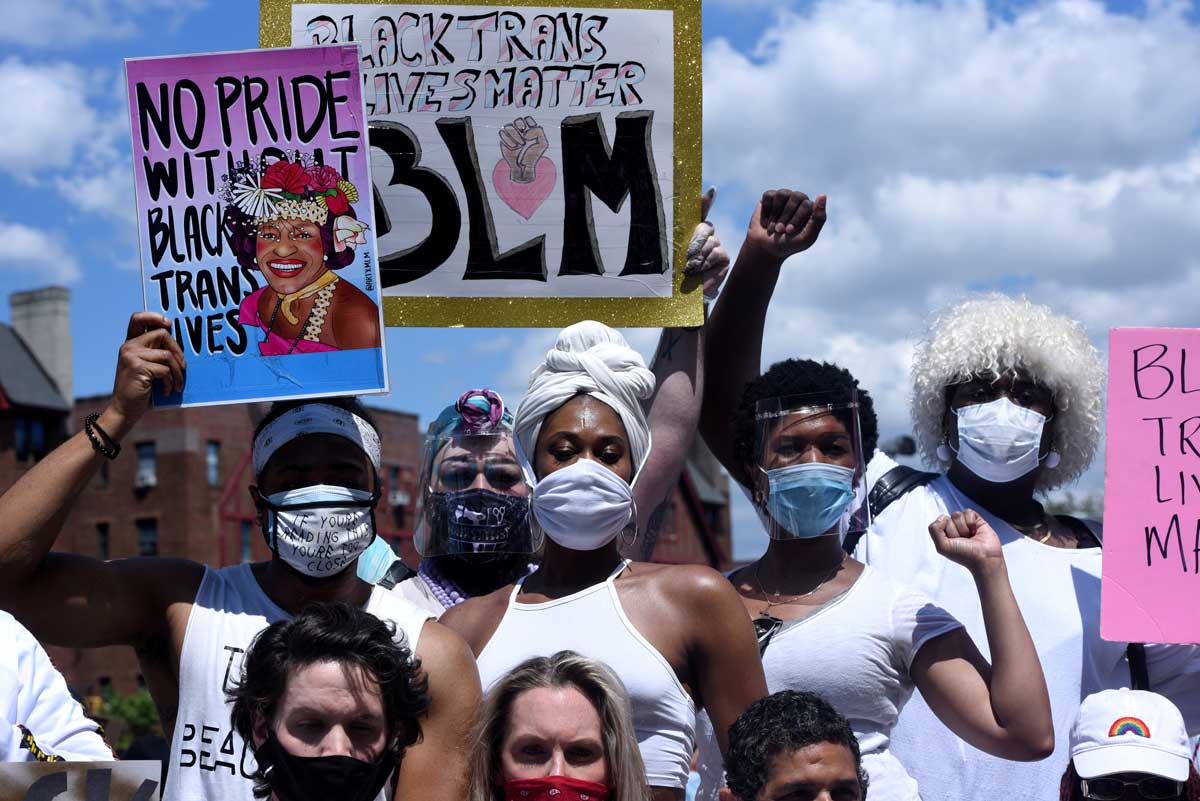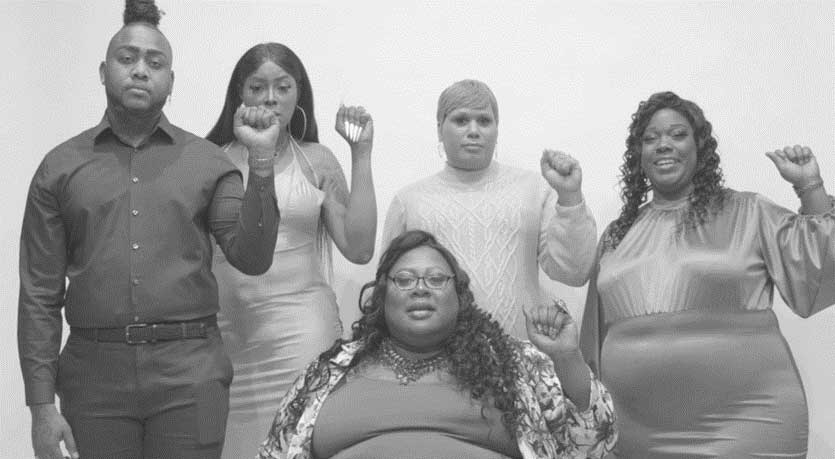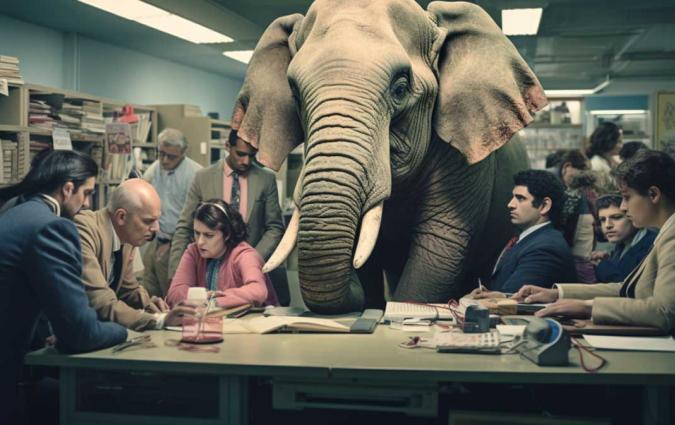In this piece
Breaking rules, forging trust: how to report on communities vulnerable to violence

People participate in a Black Trans Lives Matter rally in the Brooklyn borough in New York City, U.S., June 14, 2020. REUTERS/Stephanie Keith
In this piece
Lesson one: Invest time and research in the community | Lesson two: Work on a team with shared values | Lesson three: Be flexible with access limitations | Lesson four: Build transparent communication | Lesson five: Practice trauma-informed reportingWhen I first arrived at the Brooklyn GHOST Project and met Mother LaTravious, she assumed I’d be in and out like all the other journalists who reported on her in the past.
News organisations and reporters frequented the GHOST Project at such a rate that members of the Wednesday meetings had become immune to cameras and reporters and the excitement they can create. Every few months – around holidays like Pride Month, Juneteenth, or Trans Day of Visibility – reporters would show up for interviews.
These encounters gave Mother LaTravious a keen knowledge on how journalists report for short news segments: they’d ask her, her staff, and clients questions; get colourful shots; and then disappear. If I wanted to tell a more nuanced story about Mother LaTravious and her chosen children, I would have to take a different approach to win back their trust.

During my fellowship at the Reuters Institute, I wanted to distil the lessons she taught me about reporting on minority communities that face violence. I did so through a combination of anecdotes from my documentary, interviews with experts, and gathering resources for anyone who wants to go deeper in these skills.
Lesson one: Invest time and research in the community
Not even my continued presence at events could sway Mother LaTravious out of her PR persona, nor did it bring me closer to her chosen children. They kept me at arm’s length.
It wasn’t until I started showing up without my camera or an agenda that things started to change. The first time I attended a Wednesday meeting without a camera, I attended as a member. I sat down and broke bread with them, answered questions about myself, and played games with the group.
What surprised me the most about my interactions was that they had no clue who I was. I had attended meetings for months, but my journalist “hat” and camera kept them from seeing me not only as a person, but as a person they could trust.
This revelation led me to show up without an agenda more often. As I did, Mother LaTravious began to let her guard down and her children let me in – not only into their lives but their dynamic with Mother LaTravious as well.
I conducted many interviews during my time with Mother LaTravious. In our second interview, I asked a simple question based on some research I conducted: “I know that within the community, it is believed that Black trans women’s life expectancy is 33 to 35. What does it mean to you that you’ve lived past the age of expectancy?”
Mother LaTravious was so engaged in the question that she divulged more about herself than she had ever done before. This became her origin story in the film.
Lesson two: Work on a team with shared values
As I looked to bring on a co-director for the documentary, I knew my reputation would be on the line.
By this point, I had been able to establish a small level of trust that left Mother LaTravious and her children comfortable with my presence. I was keenly aware that the level of access the documentary needed would require an immense amount of trust building. Whoever I added to the crew would play a huge role in that build.
As a result, I looked to add people who had the same values as me when it came to reporting on trans communities.
Ideally, since I was reporting on the Black trans community in Brooklyn, the crew member would be Black and trans themselves and familiar with the community dynamics of the neighbourhood.
At a minimum I knew I’d need the following: someone who understood how to treat trans people respectfully, who believed that trans live mattered, who had a deep knowledge on what it was like to be trans, who knew about the problems affecting the trans community caused by society and institutions, who would conduct themselves as a guest within the community, who knew that trust would take time and patience, who was not afraid to rethink how stories about trans people could be told, and who would be willing to re-evaluate journalism's role based on how we have failed the community.
That last one was at the top of the list of what I was looking for in a co-director.
During my search I found plenty of people who were interested in reporting on the trans community. However, many of the people I talked to were hoping to be educated about the community at the same time or failed to use my correct pronouns.
I needed crew who were actively educating themselves not only on trans people but the Black trans community in Brooklyn, especially if I wanted to have more nuanced, deep conversations. So I kept looking.
Eventually I found Rajvi Desai: a South Asian trans nonbinary documentary filmmaker and journalist who was also looking to push the boundaries on what journalistic stories about trans people can look like. His work focused on gender issues as they intersect with race, class, and caste, both in the United States and in South Asia.
He had extensive knowledge on what it was like to be trans and was well versed in the problems trans people faced.
Even with our shared values aligning, Rajvi would go through his own tests with Mother LaTravious and her children. They didn’t welcome him with open arms, but they were not dismissive of him either. Rajvi had to prove he was worthy of their trust, and they looked to me to be the liaison for that.
Rajvi used his spare time to learn more about the local community in Brooklyn. He dug deeper into the pre-reporting I had done, paid attention to who the main players in the community were, noted the communal conversations taking place, and took the time to continuously educate himself on the intersections of being both Black and trans in the United States and how that effected Mother LaTravious and her children.
Rajvi, like me, knew that trust building would take time and that in the meantime he would be “a guest in their home” as they slowly learned to trust them. It took months before they trusted Rajvi in the same ways they trusted me. However, patience and dedication to understanding the community helped us dig deeper into the film and grow stronger bonds with our participants than I ever could have hoped for.
Lesson three: Be flexible with access limitations
Mother LaTravious eventually granted Rajvi and I more access to film at her non-profit. We went from only filming Wednesday meetings, to events, to filming business meetings and everything in between. But Mother LaTravious always became uncomfortable when asked if we could film her outside of her role at the Brooklyn GHOST Project.
I assumed she didn’t understand why it was necessary, so we took the time to explain why we wanted to capture her as a whole person – even outside of work – to aid the audience in understanding and relating to her as a person. Our explanation did nothing to comfort Mother LaTravious as she continued to resist.
I began to wonder if she did not want people to know or see where she lived for fear of her safety or embarrassment.
When I finally asked directly about her hesitancies, she admitted she was worried what people would say about the big TV screen in her bedroom.
She also felt that her personal life was not interesting enough to be filmed. Outside of work she just spent her time watching TV, undergoing dialysis, or working on new ideas for her non-profit.
It took many long and patient conversations over several months. Once we were allowed into her home, these shoots became the film’s most intimate scenes.
Lesson four: Build transparent communication
One of the first things I did after meeting Mother LaTravious was to establish transparent communication – or so I believed.
At the time, I thought open communication meant being transparent about what it takes to make a documentary, what I would need from them, and at what point in the process I was. It helped give them a real stake in the process.
But, over time, my understanding of open communication changed. As production developed and scenes started to come together in the edit, our communication evolved to sharing rough-cut scenes with Mother LaTravious and her children.
Our intention was to show them how the story was evolving as a way stoke their enthusiasm about continuing to participate. It was also to better illustrate what the gaps in filming were and why additional access was needed.
Sharing our progress visually helped us gather more information from Mother LaTravious and her children. After seeing how our shoot of her daughter’s birthday party turned into a crucial scene in the story, she had a better understanding of how events that she considered unimportant showed the dynamics of her family. After this, Mother started to share more opportunities for us to film with her family.
One of the most important things we established was how to effectively communicate with Mother LaTravious and her children. We found that weekly in-person visits with Mother LaTravious were the most effective way to keep things rolling. This helped us avoid confusion that repeatedly happened over text messages.
If face-to-face was not possible that week, we made a point to talk to them over Zoom to ensure we all had a clear understanding of what the next two weeks would look like.
Lesson five: Practice trauma-informed reporting
Rajvi and I always followed trauma-informed reporting guidelines while filming, but the most significant application happened in our final interview with Mother LaTravious.
We knew our most taxing question would be one about her longevity and her legacy as an aging trans woman.
We followed our normal procedures: mentioned at the start of the interview that this topic would come up, sandwiched emotional questions with easier ones. But when the time came for the actual question, she was clearly overwhelmed by thoughts of her own mortality, fears about her legacy, and sadness at not being able to care for the community she had created.
We sat with her as she processed this, asked if she needed a moment and gave her space. After a while, we requested consent to continue. After the interview, we made sure to ask for consent to use the interview in the film and ensured she had a support system who would be around after we left. Then we thanked her.
What we didn’t know at the time was that this was our last interview with Mother LaTravious: she died two months later, radically changing the course of our film from a documentary about her chosen family to one about how chosen families maintain legacy from one generation to the next.
For more expert insights, a reading list, and links to resources, download the full PDF below.


